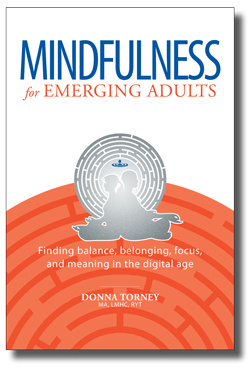Mindfulness?
Excerpted from Mindfulness for Emerging Adults: Finding balance, belonging, focus, and meaning in the digital age
By Donna Torney MA, LMHC, RYT
Mindfulness has become a household word in popular culture causing some of us to see it as just another fad. But emerging adults can trust in mindfulness practices thanks to the large body of scientific evidence proving the benefits of this once esoteric idea. Recent studies have shown that mindfulness practices can help us manage stress and anxiety, better communicate with friends and co-workers, and build our ability to give and receive love and compassion.
 Most researchers define mindfulness to include these two main components:
Most researchers define mindfulness to include these two main components:
- Mindfulness is the practice of bringing yourself back to the present moment, over and over. Our minds are wired to have a sometimes anxiety-provoking bias toward planning for the future or remembering the past. Mindfulness practices tame this bias.
- Mindfulness is reacting to the present moment without judgment. Mindfulness practices help us build the capacity to notice, without self-criticism, when we lose sight of the present moment.
One emerging adult I work with describes mindfulness as the ability to be with one’s current set of circumstances without freaking out. She tells me that mini-mindfulness breaks at her workplace help her notice when she is having an automatic negative reaction to a situation, something that was getting in the way of her success at work. By employing mindfulness she found that she was better able to stay open to present moment experience in a way that helps her feel less threatened by new people and places. This skill, in turn, helps her with making conscious choices about her future and building more successful connections with peers.
Starting in the mid-20th century, in a time when millions of people were healing from the aftermath of two world wars, theories that elaborate on optimum human development began to emerge. These theories expanded on child development to acknowledge that adults continue to grow and evolve psychosocially way beyond the point of reaching full physical maturity. But this perpetual maturing only happens if we are willing to continue learning from life experiences and adapt in healthy ways – a process that demands mindfulness.
Erikson’s stages of psychosocial development
Erik Erikson’s classic model of psychosocial development has been used as a frame for exploring human growth beyond childhood by many prominent social scientists. Erikson’s model measures timeless developmental struggles and serves as a good frame when thinking about using contemplative exercises to foster positive adult maturity. Erikson went well beyond Freud’s focus on unconscious drives, seeking to legitimize theories of human altruistic potential.
Most scholars of human development see Erickson’s stages as flexible, to be expanded or contracted based on current cultural norms. They are not necessarily completed fully and sequentially. As balance is gained in one area of psychosocial development, it will affect the next area. This is good news! Life presents many twists and turns and often we must abandon straight-forward developmental maturity in order to survive. The beauty of Erikson’s model is that it acknowledges that individuals can circle back and revisit certain developmental processes.
| Summary – Erikson’s stages of psychosocial development | ||||
| Life stage | Conflict | Resolution or value attained | Manifestation in adult life | Example |
| Infancy (0-1 year) | Learning basic trust vs. mistrust | Hope | Appreciation of human interdependence | I accept help and trust that it is available. |
| Early childhood (1-3 years) | Autonomy vs. shame and doubt | Will | Acceptance of the life cycle and impermanence | I can manage disappointment |
| Play age (3-6 years) | Initiative vs. guilt | Purpose | Humor, resiliency, compassion | I don’t take myself too seriously; I take time to enjoy life. |
| School age (6-12 years) | Industry vs. inferiority | Competence | Humility, accepting unfulfilled hopes | I have both strengths and weaknesses. |
| Adolescence (12-19 years) | Identity vs. role confusion | Fidelity | Merging of complex thought and emotions | I take both emotions and logic into account. |
| Early adulthood (20-25 years) | Intimacy vs. isolation | Love | Acceptance of the complexity of long-term relationships, openness, loving-kindness | I am willing to work to maintain important relationships. |
| Adulthood (26-64 years) | Generativity vs. stagnation | Care | Caring for others, empathy and concern | My life has more meaning when Icare for my community. |
| Elderhood (65+ years) | Ego integrity vs. despair | Wisdom | A sense of identity and integrity that tempers physical limitations | I feel content and I accept the aging process. |
A printable version of this chart can be found here.
The famous Harvard-Grant Study of Adult Development uses many of Erikson’s ideas. The Grant study followed a cohort of men who entered Harvard in the late 1930s, along with other less privileged young men. For over seventy-five years, this study has measured everything from blood pressure, to alcohol intake, to coping styles, and more recently, to brain activity. The study compares these measurements with the participant’s satisfaction and success in work and in relationships. Researchers involved with this longitudinal study are still collecting data and refining its findings on test subjects who are now in their eighth decade of life.
Most scholars of human development see Erickson’s stages as flexible, to be expanded or contracted based on current cultural norms. They are not necessarily completed fully and sequentially. As balance is gained in one area of psychosocial development, it will affect the next area. This is good news! Life presents many twists and turns and often we must abandon straight-forward developmental maturity in order to survive. The beauty of Erikson’s model is that it acknowledges that individuals can circle back and revisit certain developmental processes.
Because of the current elongated road to adulthood, (see “Are We There Yet”) there is often a blending; some might say a clash, of the adolescent and emerging adult developmental milestones of finding identity and finding intimacy. George Vaillant, long-time director of the Harvard-Grant study, states that we must first master identity before finding true intimacy. Vaillant defines mastery of identity as achieving economic, social, and ideological independence from one’s parents.
Mindfulness for Emerging Adults: Finding balance, belonging, focus, and meaning in the digital age By Donna Torney MA, LMHC, RYT is a new Whole Person Associates book. Now available for order at WholePerson.com.

